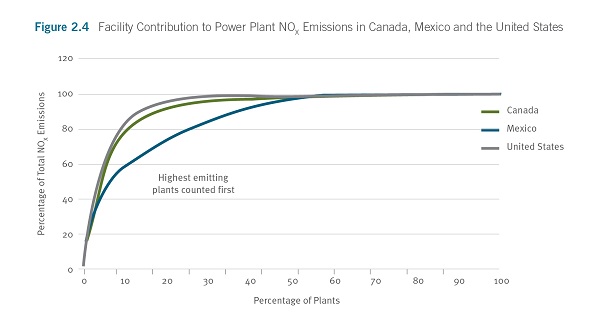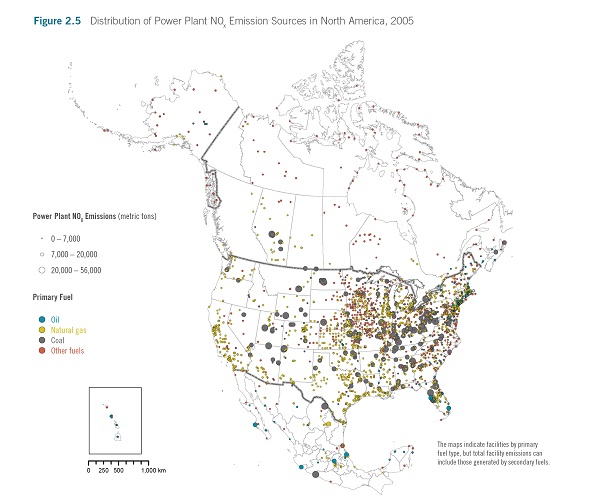Nitrogen Oxides (NOx)
In these tables, data are sorted by NOX emissions; other parameters such as electricity generation, emission rates and fuel type are also included.
In Canada, 160 plants (of the total of 189) reported their NOX emissions to the NPRI, and 27 of those plants accounted for 90% of the total NOX emissions reported by Canadian power plants for 2005. These 27 facilities emitted a total of around 207,000 tonnes of NOX.
The five plants with the highest reported NOX emissions were each in the range of 13,600 to 26,000 tonnes of NOX, with emission rates of 1.5 to 4.0 kg/MW-h, and they were all coal-fired power stations. Two of these five facilities were in Alberta, with the other three located in the provinces of Ontario, Saskatchewan, and Nova Scotia.
The top 10 facilities, as ranked by NOx emissions, accounted for 64% of the NOX emissions from the 160 Canadian power plants (Table 2.10). It should be noted that data on electricity generation were not publicly available for nearly half of these plants.
In Mexico, total NOX emissions from all 102 power plants amounted to nearly 360,000 tonnes, with the top five emitters (three coal-fired and two oil-fired) contributing 44.5% of the total. Their emissions ranged from 13,800 to 56,000 tonnes with emission rates ranging between 1.4 and 6.0 kg/MW-h.
The NOX emission rates for Mexico should be regarded with some caution, as emissions were calculated based on EPA AP-42 emission factors, rather than on observed or sampled values. The top 10 facilities, ranked by NOx emissions, accounted for 58% of the NOx emissions from all 102 Mexican power plants in 2005 (Table 2.11).
In the United States, all 2,728 power plants considered emitted a total of nearly 3,500,000 tonnes of NOX. Of these plants, 364 accounted for 90% of the total, with individual plant emissions ranging from 2,000 to 37,870 tonnes. Of these 364 plants, 97% had a NOX emission rate below 10 kg/MW-h; the highest value was 17.28 kg/MW-h. Among them, 95.5% were coal-fired and 3.2% and 1.3% were oil- and natural gas-fired, respectively.

Figure 2.4 illustrates the contribution to total NOx emissions of all the power plants in each country. It can be observed that for the United States and Canada, 10% of the total number of plants (246 in the United States and 17 in Canada) accounted for approximately 80% of each country's total NOX emissions. For Mexico, 26 plants (around 25% of facilities) contributed a similar percentage to Mexico's NOX emissions from fossil fuel power plants. Emissions from these plants were 286,339 tonnes for Mexico, 184,626 tonnes for Canada and 2,791,896 tonnes for the United States.
The geographical distribution of the NOX sources considered in this report is shown in Figure 2.5. The size of the dots represents the scale of emissions and the color represents the type of primary fuel used. In Canada, the most important NOX source is a coal-fired power plant in Alberta.
There are other important sources in this province, also coal-fired power plants, emitting between 7,000 and 20,000 t of NOX per year. There are also two coal-fired power plants in Nova Scotia with emissions in the same range. Scattered emissions sources, mainly diesel- and natural gas-fueled power plants, can also be seen across the country.
In Mexico the main NOX emissions sources are coal-fired power plants, two of which are in Coahuila near the US-Mexico border, and one located in Guerrero on the Pacific coast. Four other NOX sources with emissions in the 10,000 to 100,000 t/year range, all oil-fired power plants, are prominent and are located in Baja California Sur, Colima, Guanajuato and Veracruz.
The largest concentration of NOX sources in the United States is in the central and eastern areas of the country, with an important concentration in California as well. Coal-fired power plant NOX emissions hotspots, with emissions in the 20,000 to 56,000 t/year range, can be seen in the states of Arizona, New Mexico, Utah, Wyoming and Montana.


